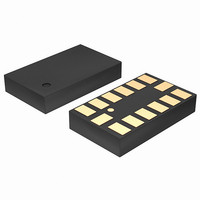LIS302DLH STMicroelectronics, LIS302DLH Datasheet - Page 14

LIS302DLH
Manufacturer Part Number
LIS302DLH
Description
SENSOR ACCELEROMETER 3AXIS 14LGA
Manufacturer
STMicroelectronics
Datasheet
1.LIS302DLH.pdf
(37 pages)
Specifications of LIS302DLH
Featured Product
STM32 Cortex-M3 Companion Products
Axis
X, Y, Z
Acceleration Range
±2.3g, 9.2g
Sensitivity
18mg/digit, 72mg/digit
Voltage - Supply
2.16 V ~ 3.6 V
Output Type
Digital
Bandwidth
100Hz ~ 400Hz Selectable
Interface
I²C, SPI
Mounting Type
Surface Mount
Package / Case
14-LGA
Package Type
LGA
Operating Supply Voltage (min)
2.16V
Operating Supply Voltage (typ)
2.5V
Operating Supply Voltage (max)
3.6V
Operating Temperature (min)
-40C
Operating Temperature (max)
85C
Operating Temperature Classification
Industrial
Product Depth (mm)
3mm
Product Height (mm)
0.92mm
Product Length (mm)
5mm
Mounting
Surface Mount
Pin Count
14
Sensing Axis
Triple
Acceleration
2 g, 4 g, 8 g
Digital Output - Number Of Bits
16 bit
Supply Voltage (max)
3.6 V
Supply Voltage (min)
2.16 V
Maximum Operating Temperature
+ 85 C
Minimum Operating Temperature
- 40 C
Digital Output - Bus Interface
I2C, SPI
Lead Free Status / RoHS Status
Lead free / RoHS Compliant
Other names
497-10052
Available stocks
Company
Part Number
Manufacturer
Quantity
Price
Company:
Part Number:
LIS302DLHS0.5
Manufacturer:
INNOLUX
Quantity:
1 000
Company:
Part Number:
LIS302DLHTR
Manufacturer:
SANYO
Quantity:
11
Mechanical and electrical specifications
2.5
2.5.1
2.5.2
2.5.3
2.5.4
14/37
Terminology
Sensitivity
Sensitivity describes the gain of the sensor and can be determined e.g. by applying 1 g
acceleration to it. As the sensor can measure DC accelerations this can be done easily by
pointing the axis of interest towards the center of the earth, noting the output value, rotating
the sensor by 180 degrees (pointing to the sky) and noting the output value again. By doing
so, ±1 g acceleration is applied to the sensor. Subtracting the larger output value from the
smaller one, and dividing the result by 2, leads to the actual sensitivity of the sensor. This
value changes very little over temperature and also time. The sensitivity tolerance describes
the range of Sensitivities of a large population of sensors.
Zero-g level
Zero-g level offset (TyOff) describes the deviation of an actual output signal from the ideal
output signal if no acceleration is present. A sensor in a steady state on a horizontal surface
will measure 0 g in X axis and 0 g in Y axis whereas the Z axis will measure 1 g. The output
is ideally in the middle of the dynamic range of the sensor (content of OUT registers 00h,
data expressed as 2’s complement number). A deviation from ideal value in this case is
called Zero-g offset. Offset is to some extent a result of stress to MEMS sensor and
therefore the offset can slightly change after mounting the sensor onto a printed circuit
board or exposing it to extensive mechanical stress. Offset changes little over temperature,
see “Zero-g level change vs. temperature”. The Zero-g level tolerance (TyOff) describes the
standard deviation of the range of Zero-g levels of a population of sensors.
Self-test
Self-test allows to check the sensor functionality without moving it. The self-test function is
off when the self-test bit (ST) of CTRL_REG4 (control register 4) is programmed to ‘0‘.
When the self-test bit of CTRL_REG4 is programmed to ‘1‘ an actuation force is applied to
the sensor, simulating a definite input acceleration. In this case the sensor outputs will
exhibit a change in their DC levels which are related to the selected full scale through the
device sensitivity. When self-test is activated, the device output level is given by the
algebraic sum of the signals produced by the acceleration acting on the sensor and by the
electrostatic test-force. If the output signals change within the amplitude specified inside
Table
within the defined specifications.
Sleep to wake-up
The “sleep to wake-up” function, in conjunction with low-power mode, allows to further
reduce the system power consumption and develop new smart applications.
LIS302DLH may be set in a low-power operating mode, characterized by lower date rates
refreshments. In this way the device, even if sleeping, keep on sensing acceleration and
generating interrupt requests.
When the “sleep to wake-up” function is activated, LIS302DLH is able to automatically
wake-up as soon as the interrupt event has been detected, increasing the output data rate
and bandwidth.
With this feature the system may be efficiently switched from low-power mode to full-
performance depending on user-selectable positioning and acceleration events, thus
ensuring power saving and flexibility.
3, then the sensor is working properly and the parameters of the interface chip are
Doc ID 15797 Rev 1
LIS302DLH













